Introduction Tsavo ecosystem continues to witness a dry spell that is expected to continue way into mid October
Introduction
Tsavo ecosystem continues to witness a dry spell that is expected to continue way into mid October. Forage and food availability continue to dwindle and cases of Human-wildlife conflicts and poaching incidences continue to be reported. The use of arrows and snares re now more common due to their silent nature as opposed to use of guns that will arouse suspicion from the tightened security in the region.
Treatment of an Elephant at Galana Tsavo East A report of a male elephant with hanging intestines was received on 31st August. Galana, Tsavo East. A veterinary team visited the area to attend to the case. After observation a decision was made to immobilize the animal for examination and treatment. Darting: A preparation of etorphine 18mg in a 2ml dart was made. Using dan-inject rifle, the elephant was darted from a vehicle. Immobilization took 9 minutes to take effect. Observation: The male elephant had a wound on the skin in the stomach region and the muscles were hanging out. However it was not a penetrating wound. Management: The infected region was cleaned using clean water and hydrogen peroxide. It was then lavaged using povidone iodine. All the dead matter was debrided to give a fast healing effect. Tetracycline wound spray was sprayed on the wound. The elephant was injected with 20000mgs of tetracycline (L.A) at two different sites into muscles. The operation took 20 minutes Reversal: The reversal was done after management of the wound. A preparation of 54 mg diprenorphine was administered IV into the ear vein. The reversal took 5 minutes and the elephant was up again and strong.
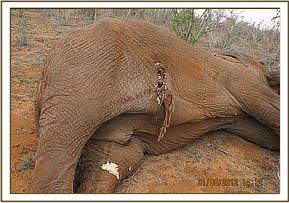
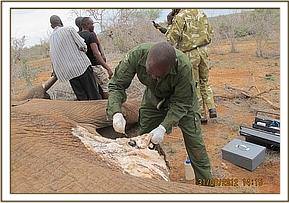

Treatment of an Elephant cow and its calf in Rukinga Ranch, Tsavo East, 4th Sept. The cow was reported to have a suspected abdominal arrow wound and was accompanied by a limping calf with leg injury. Both were darted using 16 mgs and 5 mgs of etorphine for the dam and calf respectively. Management: The wounds on the left knee joint for the calf suspected sustained from an arrow shot was cleaned with water mixed in antimicrobials and long acting antibiotics administered. The dam with an arrow shot on the right groin area which was removed, the wounded area cleaned and antibiotics administered. Reversal: Was done by administration of diprenorphine Hcl at three times the etorphine dose intravenously at the ear vein. They both woke up and walked away. Prognosis- Good for the cow and guarded for the calf.
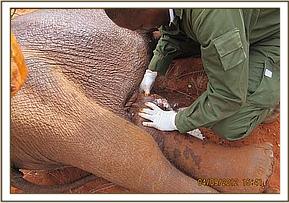
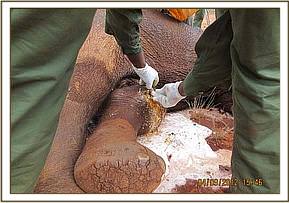
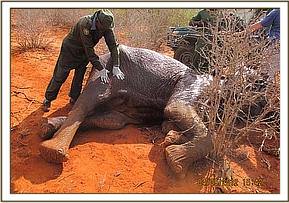

Treatment of an injured Elephant bull in Komboyo, Tsavo West; 10th Sept. The huge bull was sited within Komboyo in Tsavo West Park with pus draining from a wound on its left flank. He was in a group of 3 other males. Immobilization was done using 18 mgs of etorphine in a dan inject system and the elephant fell in 5 minutes. Ropes and a vehicle had to be used to pull him over as he fell on the injured side. A deep wound suspected sustained from an arrow shot was clean, pus drained and dead tissues cut off. Antimicrobials were added to the wound to prevent bacterial infection. He was revived using diprenorphine at three times the etorphine dose. Prognosis is good.
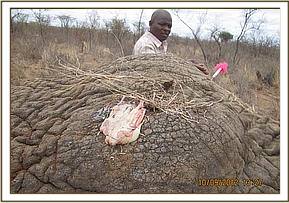
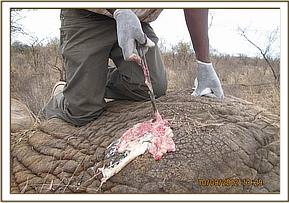

Treatment of an injured Elephant bull at Finch Hattons, Tsavo West 14th Sept. The sub-adult bull was spotted near finch hattons hotel hardly moving due to great pain on the right forelimb emanating from a wound at the chest that has spread infection to the limb. The wound is thought to be arrow wound. Darting was done using 16 mgs of etorphine and the Elephant hardy moved 10 meters before going down. The wound near the throat was cleaned with antimicrobials and antibiotics applied. Parenteral long acting antibiotics and anti-inflammatories were administered. Revival was done using diprenorphine at three times the etorphine dose. He had be assisted to stand as he was very weak. Prognosis- Guarded

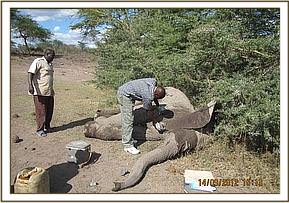
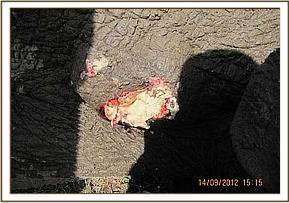


Examination of a calf that succumbed to drought/water scarcity, in Satao Tsavo East, 18th Sept. The continuing dry spell is taking toll on the survival of young calves that have to endure walking for long distances to accompany their family members in search of food and water. This particular calf succumbed barely 100 meters to the water hole in Satao. Examination revealed malnutrition, poor body condition and exhaustion being the cause. The numbers of rescued elephant calves are on the increase due to mortalities of their mothers and separation occasioned by the harsh weather conditions being experienced late. Treatment of an snared Elephant at Shimba hills reserve, 19th Sept.
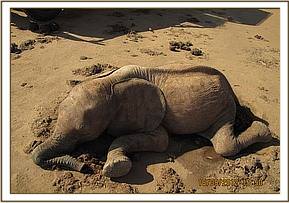
A report of a male elephant with severe lameness was reported at Shimba hills game reserve on 19th September 2012. A veterinary team visited the area to attend to the case. Darting: A preparation of etorphine 18mg in a 2ml dart was made. Using dan-inject rifle, the elephant was darted on foot darting. Immobilization took 5 minutes to take effect. Observation: The male elephant had a snare on the distal left front foot. The snare had caused a deep severe wound all round the foot. There was also puss oozing from the wound. Management: The snare was removed and a 5 cm deep wound all round the foot observed. The infected region was cleaned using clean water and hydrogen peroxide. It was then lavaged using povidone iodine. All the dead matter was debrided to give a fast healing effect. Tetracycline wound spray was sprayed on the wound. The elephant was injected with 20000mgs of tetracycline (L.A) at two different sites into muscles.The reversal was done after management of the wound. A preparation of 54 mg diprenorphine was administered IV into the ear vein. The reversal took 7 minutes for full recovery. Prognosis - Good
Rescue of an Elephant that was being poached within Voi River, Tsavo East, and 21st Sept. Introduction In my several years working as a Vet in Tsavo and Kenya as a whole, no other case of Elephant suffering touched me like this one Elephant, due to its immense strength to survive and the strong will he had. The case was spotted by rangers along the now dry Voi River, where the alleged poachers fled on hearing rangers approach on the evening of 20th September 12. Because the rangers thought it was late to inform the vet, the report was received the next morning where we rushed fast to find the near suffocating elephant already on the ground with 5 fresh arrows stuck in its body. With the Elephant nearing death amid struggles, etorphine was hand injected to immobilize him as the tight wire snare was cut off from the attached tree. As the rangers struggled to loosen the noose, the vet was busy removing the fresh arrows heads and treating fresh wounds. The final struggle Having struggled the whole night with no more energy to spare, the elephant was too weak to stand. Pulling him up using a vehicle was made difficult by the thick bushes along the now dried up river. After a two hours struggle, a point where the rangers had called in for an axe to remove the tusks, he finally stood up to the excitement of all! All the rangers predicted that that elephant will live long and be among the Elephant genes of the future.
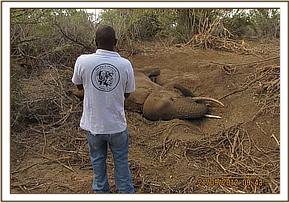
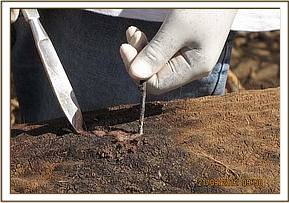
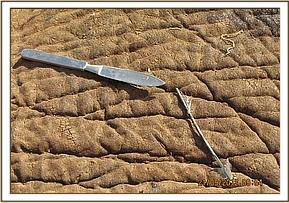
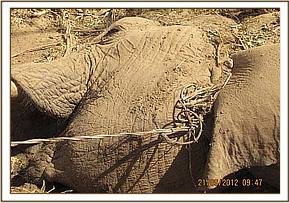

Treatment of a snared wild pig in Kisite Mpunguti marine reserve, 28th Sept. 12 Though our work resolves around the big five and other endangered species, we value all wildlife as in the case of this wild pig that was snared in the Park headquarters of Kisite mpunguti marine reserve at the south coast. The pig was manually restrained using a fish net and the snare removed, wounds cleaned and a final injection of antibiotics administered. He was released to the nearby forest that forms part of the reserve.

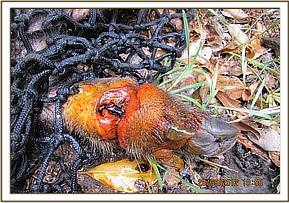

Treatment of a snared Elephant cow in Rukinga ranch, 29th Sept. 12. Rukinga as of late become an injury hot spot due to its strategic location next to Tsavo East National Park plus feed and water availability that attracts many elephants form the park and the surrounding ranches. Darting; done using 16 mgs of etorphine in a dan inject system. A deep cutting wire snare around the neck was cut loose and deep pus oozing wounds were carefully cleaned using water mixed with hydrogen peroxide. Iodine and oxytetracycline spray was applied and antibiotics and anti inflammatories injected IM and IV respectively. She was finally assisted to her feet as she was too week. Prognosis- good
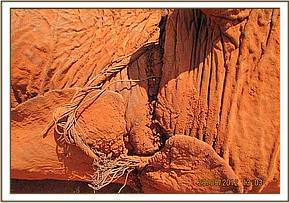
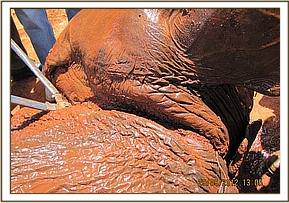
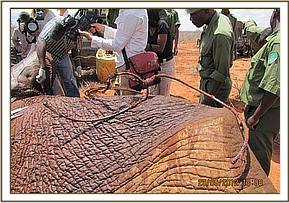

Report By: Dr Jeremiah Poghon
The Mobile Veterinary Unit operated by The David Sheldrick Wildlife Trust working with The Kenyan Wildlife Service and funded by Vier Pfoten.